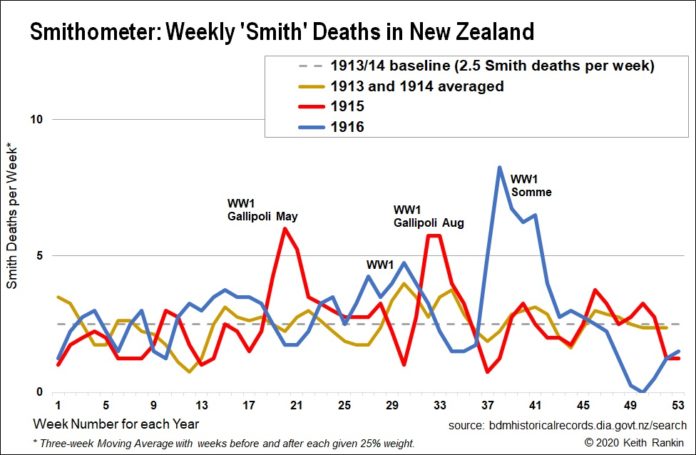Analysis by Keith Rankin.
Today’s Anzac Day Smithometer Chart shows the fatal impact in New Zealand of World War 1 battles at Gallipoli and on the Somme in France. (Earlier this week the Smithometer showed the impact of 1917 WW1 battles in Belgium – Messines and Passchendaele – and the dramatic, though short-lived, impact of the 1918 influenza pandemic.)
These two charts show that most of the combat death in World War 1 was linked to just five periods each of one or two weeks: Gallipoli in May and August 1915, the Somme in September 1916, Messines in June 1917, and Passchendaele in October 1917. The Smithometer shows that much of World War 1 was inactivity, at least in the military sense.
The total number of Smith deaths in 1915 was the same as in 1914, when there were no Smith war fatalities. Seventeen percent of Smith deaths in 1914 were infants (under one year old); a worse year for infant mortality than 1913. Eighteen percent of Smith deaths in 1915 were due to the war, and thirteen percent were infants. Total Smith deaths in 1915 and 1916 were 288, just ten percent higher than for 1913 and 1914. Deaths not related to war or infancy were noticeably down in 1915 and 1916. The war did not increase New Zealand’s crude death rate by as much as most of us would have expected.
Smith deaths in New Zealand were unusually low in 1919, and with only eight infant deaths (6.6 percent of all deaths). However, in 1920 infant mortality returned to the high 1914 rate of 17 percent. This rise in part but not entirely reflected increased numbers of infants in 1920, after the soldiers returned from the war. The male babies born at this time represented the core fighting force in World War 2.








